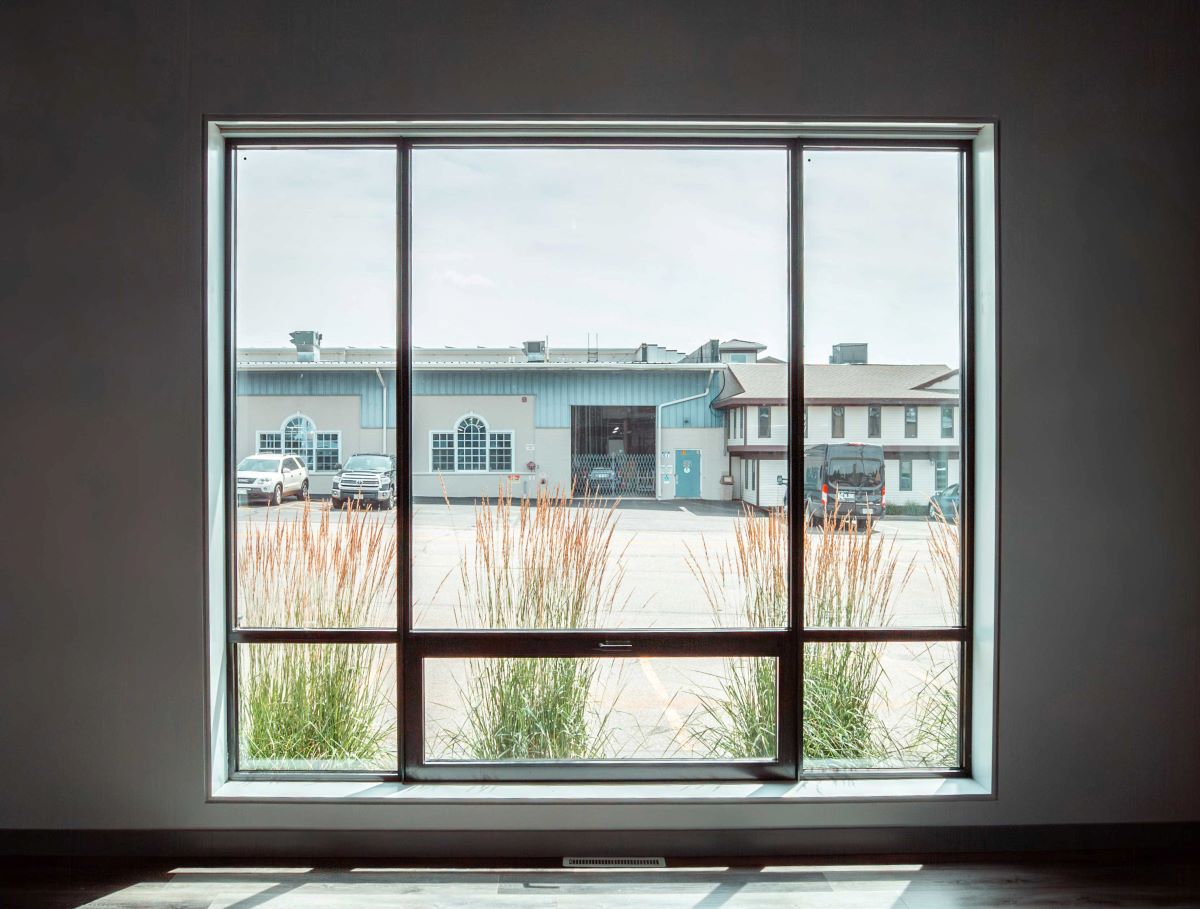VIG in Action
Vacuum insulating glass gains traction in the residential market

Pictured: Enthermal and Enthermal Plus vacuum insulating glass offerings by LuxWall Inc. integrated into select Ultra Series and VistaLuxe WD Line window and door products by Kolbe Windows & Doors. Photos courtesy of Kolbe Windows & Doors.
As companies explore more options for energy-efficient products, some are looking at their glass packages, including vacuum insulating glass, or VIG.
Kolbe Windows & Doors and LuxWall in 2024 announced a partnership in which LuxWall would offer vacuum insulating glass as an option in certain Kolbe products. In September of this year, Kolbe launched the technology into select window and door products.
LuxWall offers two types of VIG: Enthermal, a two-pane tempered glass system with a vacuum space and one low-emissivity coating, and Enthermal Plus, a three-pane tempered system with a vacuum space, two low-e coatings and additional customization options.
The LuxWall plant, located in Ypsilanti, Michigan, encompasses about 215,000 square feet and heavily leans on automation with conveyors, robots and more. Scott Thomsen, co-founder, chairman and CEO of LuxWall, says the automation was an intentional move to help drive VIG costs down as low as possible.
VIG isn’t a new technology—its first patents date back to the 1960s—but its introduction to the residential space is. Thomsen and Kolbe Windows & Doors president Jeff DeLonay cite high energy demands and the consumer looking for efficient options as primary drivers for now being the right time to bring this technology to market.

Practical considerations
Thomsen references commercial retrofits, where glazier partners remove existing glass, install VIG and, even in cases where the frame isn’t of high quality, Thomsen says owners report return on investment within three to 10 years. “That’s why we started on commercial, but we’re seeing a pull earlier than we expected in residential,” he says. VIG meets considerations of northern and southern climates in that it can keep occupants comfortable through extreme cold temperatures but also meet demands of protecting a home and lowering cooling costs in the southern markets.
The change to VIG was fairly smooth on the assembly side, says John Budzynski, product certification manager, Kolbe Windows & Doors, with most products requiring minimal changes. “Certain products do perform better by their design and in our R&D work, we’re looking at other things to go even further with that ability to design with the IG to make even more performance-enhancing changes.”
The pillars inside a VIG unit are of more concern to homeowners than they are in commercial or institutional settings. The Kolbe team of distributors ensures consumers are aware of the pillars so there are no surprises. Like much of the rest of the technology, however, pillars have advanced. “We’ve had architects spend a good part of the day talking about the glass, handling the glass, looking at it and not seeing the pillars; we have to bring it to their attention,” says Budzynski.
To further test the pillar visibility, Kolbe took a window and door to the International Builders’ Show earlier this year and asked people to look at the glass, rather than through it, to see if they could detect the pillars. Even as close as a foot away, most people couldn’t see them.
LuxWall’s pillars, for example, are 0.5 millimeter in diameter and quite difficult to see.
Many standard casement windows are 1 ¾ inches thick or 1 3/8 inches thick, which can limit the thickness of glass. Triple panes, for example, could require a sash about 2 ¼ inches thick. VIG can easily fit into the standard size, which reduces the necessary amount of sash material. “It will work especially well in a double-hung product,” says DeLonay.
Market conditions
Despite some tax incentives for high-performance windows and doors sunsetting, the Kolbe team still believes this is a very sellable product. Kolbe anticipates selling VIG more so than triple pane, in part because it weighs less and carries a higher performance value. It can also go in high-altitude areas without the need to breathe or tube it.
Education is another large part of bringing VIG to market in a larger way. “Even today, when we have our business development people calling on architects, a lot of our architects aren’t aware of what it is,” says DeLonay. “there’s an education process, but once that is overcome, I think you’re going to see a waterfall effect.”
Thomsen sees awareness as one of the top challenges. His conversations have run the gamut of those who are aware of VIG and those that have no idea about it. He says as more projects are completed and more case studies come to light, the better it will be for awareness. “It’s building awareness, proving it really works and it’s easy to install. That’s key right now,” he says.
Vacuum Insulating Glazing, an Introduction
The following is excerpted from NGA’s Glass Technical Paper FB66-20: Vacuum Insulating Glazing, an Introduction. Download the full paper in the NGA Store
Vacuum insulating glass provides similar or superior thermal performance to conventional double glazing in the thickness of a single glass lite. The gas in the space between two lites of glass is extracted to create a vacuum, rather than filled with air or argon. The thin profile can be installed in new construction, restoration projects and refrigeration applications.
VIG comprises two glass lites, typically 0.12 inch to 0.23 inch (3 to 6 mm) thick that are hermetically sealed around the edges. The air between the two lites is extracted, either through a small pump-out tube (also known as an evacuation port) or by using a vacuum chamber. The glass lites remain separated by pillars (also called microspacers) approximately 0.005 inch to 0.012 inch (0.15 mm to 0.30 mm) thick. The pillars are made of high strength material such as metal or ceramic and may be arranged in various patterns across the surface of the glass. Examples of patterns are a uniform grid or in a pattern spaced wider in the center of the array and closer together toward the edges. The pillars may be glued in place or held in place by the glass. Once a vacuum is made, the edges (and the pump-out tube if applicable) are sealed to create a permanent vacuum. For units that have a visible pump-out tube, there may be a safety cap placed over the tube for additional durability. Some VIG units may include a getter; a component in the VIG that continually removes residual outgas molecules to help maintain vacuum over time. A getter may be a separate, visible component or incorporated in another component of the VIG, such as the edge seal.
The pressure of the evacuated cavity is typically on the order of 0.1 pascal to eliminate the conductive and convective heat exchange between the two lites of glass. To reduce radiative heat exchange, a low-emissivity coating can be used on one of the internal surfaces of the VIG, typically surface 2.
Matching flatness on both lites of glass is critical to successful VIG fabrication to keep the array of pillars in place. Keeping the pillars in place prevents the lites from touching to avoid creating a thermal conduction pathway that could reduce the performance of the VIG.
Current VIG market application
New construction. VIG can be installed as a monolithic lite or as part of an insulating glass unit. Hybrid VIG can be used to further reduce U-factor and solar heat gain coefficient. In a hybrid VIG unit, one of the lites of a standard double glazed IGU with air or gas-filled space is replaced with a VIG. Laminated VIG can be used to improve sound control, add protection against impact from wind-borne debris or forced entry, and comply with the requirements of safety glazing. In a laminated VIG unit, one of the lites of a standard double-glazed laminate is replaced with a VIG. In these constructions, the lite added to the VIG may be heat-treated, have a low-e coating, or have other properties that improve the thermal or acoustic performance. Double or triple insulated units using VIG to replace individual glass lites is also possible for future development.
New construction design with VIG offers two distinct benefits compared to traditional glazing:
- Frame/sash design or weight design: VIG offers higher energy performance in a significantly thinner profile than typical IGU construction. This benefit allows window and sash designs that are much thinner or lighter weight than typical construction methods using IGUs. The key benefits of a thinner profile product include wall thickness, window thickness, matching existing window extrusion design or to reduce overall glazing component weight.
- Higher performance for given profile: By utilizing the VIG either as a standalone product or in a hybrid VIG, manufacturers can exceed the performance values of typical IGU design required by model building codes. VIG can enable compliance with more stringent energy standards such as Passive House, Local Law 97, etc.
Energy Performance. Key drivers for energy performance include pillar array, vacuum level and the addition of low-e or other solar coatings.
- Pillar array: The pillar array affects convection and conduction components of heat transfer. The distance between pillars can be increased if thicker glass or heat-treated glass is used. A wider pillar array allows for less heat transfer, so a lower (better) U-factor can be achieved. However, a wider array must not allow the two lites to touch, which may cause unacceptable glass distortion and be aesthetically unappealing.
- Glass coating: The emissivity of the glass coating, along with the placement and number of coatings used drives the energy performance as well. A higher performing low-e can reduce both the SHGC and the U-factor, as they would in a standard IGU.
- Vacuum level: Lower pressure reduces heat flow.
Acoustic Performance. Sound waves do not travel through a vacuum, so the VIG design may offer improvements in acoustic performance and a reduction in sound transmission. In general, VIG offers improved sound reduction performance when compared to a single lite with the same thickness as the VIG unit. VIG can be combined with lamination, acoustic PVB and hybrid IGU design to further improve sound attenuation. Refer to VIG fabricator for product-specific acoustic performance.
Shipping. Because VIGs are hermetically sealed with a low vacuum pressure, the shipping and installation altitudes compared to manufacturing location are negligible. As such, VIG can be air freight shipped or installed in high altitude locations without issue. Hybrid VIG/IGU units must be treated the same as standard IGU glazing.
